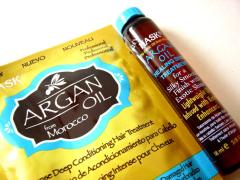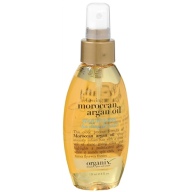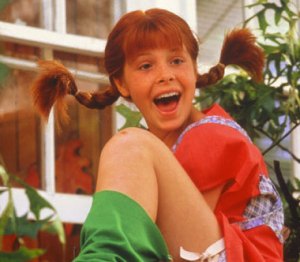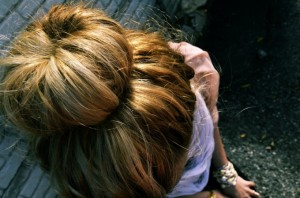Hello dear readers! It’s been a while. I make a point of only posting when I have something truly worthwhile to say, so I apologize if you’ve been feeling neglected.
 I’ve come across a slew of timely new products that don’t seem to be a total waste of money and are worth the investment: Easy-to-use hair oils. They come in many different brands and consistencies with a plethora of ingredients and application techniques that offer various benefits to hair and styling. I’d feel remiss if I didn’t mention that this is not a “new hair trend” by any means. Go to the small but super important “coarse hair” section of any drugstore and you’ll see products similar to these that have been on shelves for decades. This bevy of new contenders just comes in prettier packaging with highly-marketed branding, and the oils tend to be a bit more distilled so that they don’t weigh down finer hair types.
I’ve come across a slew of timely new products that don’t seem to be a total waste of money and are worth the investment: Easy-to-use hair oils. They come in many different brands and consistencies with a plethora of ingredients and application techniques that offer various benefits to hair and styling. I’d feel remiss if I didn’t mention that this is not a “new hair trend” by any means. Go to the small but super important “coarse hair” section of any drugstore and you’ll see products similar to these that have been on shelves for decades. This bevy of new contenders just comes in prettier packaging with highly-marketed branding, and the oils tend to be a bit more distilled so that they don’t weigh down finer hair types.
 The first thing you should know is that the coarser the hair, the bigger the “pores,” and the more moisture that is needed. Think of hair porosity in terms of a big sea sponge with huge divots. The holes of the sponge are big so that they can absorb a ton of liquid easily, but the water also squeezes out more easily than it does in a more condensed sponge. Hair is this way too — if it thirstily absorbs everything you put on it, it loses moisture just as easily.
The first thing you should know is that the coarser the hair, the bigger the “pores,” and the more moisture that is needed. Think of hair porosity in terms of a big sea sponge with huge divots. The holes of the sponge are big so that they can absorb a ton of liquid easily, but the water also squeezes out more easily than it does in a more condensed sponge. Hair is this way too — if it thirstily absorbs everything you put on it, it loses moisture just as easily.
Below I’ve broken down a few that I’ve tried, which I’d recommend based on hair type, and how to use them. But first, a few ground rules.
1) Concentrate on strand ends when using oils. The ends don’t get as much love from natural scalp oils, especially on a curly head, and this is a big part of what causes split ends. And don’t shortchange your shorter layers — they have ends too!
2) Just because a product says to use it on wet or damp hair only, this doesn’t mean it’s a hard and fast rule. Hair absorbs more when it’s not wet — this is common sense. When it’s wet, it has already absorbed some water. When it’s dry, it’s only absorbing what you put on it. If your ends are feeling very dry, I’d definitely recommend using oil on them when hair is not wet.
3) Regardless of what some packaging may claim, hair oils are not a replacement styling product. They can be, if you’re ok with a slightly less tame hair day, because they will not hold curls together in a cast while they dry the way gels, mousses, and creams do. For an everyday look, you should probably expect to wear hair in a braid or bun that day to hide the greeeez.
4) How much you apply depends on when you are using it. Refer to the point above. I don’t style with oils on the “first day” of a hair wash cycle. Usually it’s when I go on to a third or fourth day that I start to feel like it’s a bit dry from days without conditioner. However, with very light application, and with a lighter oil mix, you can get away with running a bit over your gelled hair without greasy side effects. We also tend to wash less in the winter, and that’s when hair needs moisture the most. You will not use oils as much in the summer, but they are a great little product to pack in the beach bag for use after chlorine or saltwater abuse!
5) Your scalp can also benefit from oils. Itchy? Painful? Flaking? All of these can be side effects of a dry scalp. Not everyone gets dandruff, and dandruff is not the only indicator of a scalp in distress. Even if you have one spot that seems especially painful, rubbing a dab of oil or conditioner on that spot will soothe it instantly. It’s like magic. So if you’re already applying it to your ends, why not go all the way? But beware — this is an application site that will make hair look pretty greasy and you may not want to do it just before stepping out for the evening or heading to work. On the weekend? Cover up the evidence with a cute bandana or hair scarf.
6) Why not just use the EVOO in my kitchen cupboard? Ahh, the million dollar question! You can do that if you spruce it up with lots of yummy-smelling quality essential oils and mix them together before application. Otherwise, you will just smell like a fry cook all day, and you may get sick of that (unless you actually are a fry cook, in which case, go for it!) This is why I recommend the homemade oil treatment as an overnight remedy, not something to leave in your hair during an average day. The products below smell amazing, so any questions regarding your hygiene should be quickly dismissed.
7) Use hair oils as often as you feel is necessary, based on hair’s absorption. There is no drawback to using them, but if you over-do it you will see that it gets super greasy because it can only absorb so much. Over-saturation serves no purpose! You will know how to toe the line with your hair as you become more accustomed to using oils.
8) Wash with a real cleanser at least once a week when you are using oils. They don’t wash out with water and conditioner like other products and environmental deposits do. Because of this, you’ll want to treat hair, and especially your scalp if you’ve used it there, to some DevaCare Low ‘Poo, No ‘Poo, Homemade Lemon Juice-Conditioner cleanser, or WEN’s cleansing conditioner during shower time.
9) Start small. A dime-sized dab in the palm will go a long way. My hair is down to the middle of my back and that’s all I usually need, concentrating on ends and mid-length. If you need more you can always add more, but add in very small increments. Rub palms together and rake the oil through hair where it’s needed most.
10) When in doubt, read the ingredients!! Google any that you don’t know and you should get a good idea of how good or bad they are for your hair. Some synthetics can be extra slick, coating strands with more shine than moisture, so it’s best to go with products that have as short an ingredient list as possible.
Now, without further ado…
 Ojon
Ojon
– Course to fine type –
Ojon’s products come in two super-handy applications for all hair types. The first is in a bottle, and you can use it based on your hair’s absorption power with a dab in your palm that you rake through pretty liberally. If you need more, use it, but start small. The second applicator is like a mascara wand that can be used for flyaways. If you have a ponytail, say, and there are a few baby hairs that just won’t lie down, skim the wand over the trouble spots and they will simmer right down. This also works really well for straight-haired and short-haired ladies and gentlemen with stubborn cowlicks, so surprise your un-blessed friends with your new-found hair-saving savvy!
 Palmers
Palmers
– Coarse type –
Palmers’ products tend to be a bit on the gooey-er side, and can be used even more sparingly than the others. Coarse is not synonymous with thin — this hair type breaks more easily than all others, so oils are essential and Palmers makes a great product. Just because it comes in a spray bottle, that doesn’t mean you have to use it that way — in fact, I don’t recommend it. With a dab in the palm you are better able to control the amount that you’re using and where it’s being applied.
 Hask Argan Oil
Hask Argan Oil
– Coarse to fine type –
Argan Oil can be found in many product lines now, and with a variety of thicknesses and added ingredients. I like the Hask version, and it smells like a creamsicle. I use it more than any others, and it’s pretty thick so use sparingly and mainly at the ends.
 MorrocanOil
MorrocanOil
– Coarse to fine type –
MorrocanOil makes a long line of Morrocan oil products that have been widely circulated through the United States and they tend to stick to sparse, helpful ingredients. Their trademarked original oil is another example of a top notch product without too many unnecessary add-ons.
 Organix
Organix
– Medium to fine type –
Organix Penetrating Oil Renewing Moroccan Argan oil is my newest favorite for my fine hair type. It’s light enough not to look greasy, smells so good, and comes in an easy-application pump bottle. It may not offer enough oomph for coarser hair types.




















